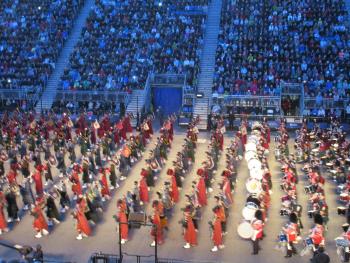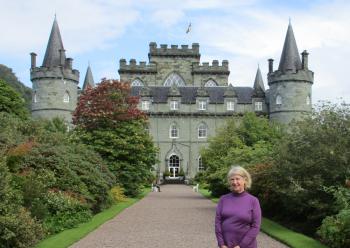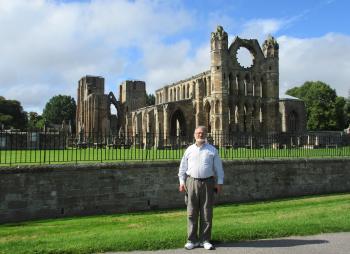An independent journey along the back roads of Scotland
This article appears on page 35 of the August 2018 issue.
For years, Marvin dreamed of attending the Royal Edinburgh Military Tattoo in Scotland. As we were to celebrate our 25th wedding anniversary in August 2017, we saw a trip to Scotland and, in particular, the opportunity to attend a performance during the annual, 3-week Tattoo as a fine excuse for going there.
Although we live in Florida, a summer family gathering would take us to Los Angeles, so it was easy for us to head directly to Scotland from there. From LA, we flew on Aer Lingus to Edinburgh via Dublin. It was quite a jolt to our bodies, heading from the summer heat of LA to chilly, windy and often rainy Scotland, but, equipped with warm coats and beanies, we soldiered on.
Edinburgh
The Royal Edinburgh Military Tattoo exceeded our expectations. For nearly two hours, we watched hundreds of bagpipers, drummers, international military bands and brightly dressed dancers and singers perform the most stirring show we have seen in our lives! It was a dazzling, breathtaking spectacle that thrilled us from beginning to end. This was a fabulous introduction to our Scotland visit.
Not surprisingly, Edinburgh was packed with thousands of tourists, many of whom (like us) came for the Tattoo. But there was so much else going on, including the Edinburgh International Festival and the Edinburgh Festival Fringe, with dozens of offerings on the streets and in various venues.
Our traditional, small, comfy Scottish guest house, Ascot Garden B&B (154 Glasgow Rd.), booked through an Internet website for $90 per night, was perfectly located for taking public transport throughout the city (no car needed in Scotland’s capital).
Our Tattoo package tickets (about $170 each) also included a tour to The Famous Grouse whisky distillery, where Marvin sampled “a wee drop.” Other stops on the tour included historical monuments to Scottish heroes, including the National Wallace Monument to William Wallace of “Braveheart” fame, and The Hermitage, a lovely National Trust for Scotland park, where Marvin was surrounded by dozens of young Hassidic boys on an excursion who were curious to learn about Judaism in the US.
Among the highlights during our 4-day DIY (do-it-yourself) Edinburgh stay were a rainy-day visit to the National Museum of Scotland, a huge complex where we had time to explore only the vast Scotland wing; a lovely walk (free entry) — on a sunny but cold day — in the tranquil Royal Botanic Garden Edinburgh, one of the finest in the world and a renowned scientific research center; a fascinating tour (senior price, £13.75, or $18) of the now-decommissioned Royal Yacht HMY Britannia, and a tour through the magnificent Palace of Holyroodhouse (senior price, £11.60), the Queen’s official residence in Scotland and once the home of the ill-fated Mary Queen of Scots. History buff Carole loved it all!
On the road
After our wonderful Edinburgh sojourn, we needed a rental car (something we don’t usually use overseas) for our meanderings around Scotland. Although it had been a while since Marvin had driven a manual-shift car — and on the “wrong” side of the road — he adjusted fairly quickly, and off we headed.
Our first stop was Stirling Castle, where we found hordes of Sunday visitors to this prime tourist spot on a rare sunny Scottish day. The surprising enormity of the complex amazed us, so we picked just some of the sites in this village-within-a-castle.
Its strategic location, atop a mountain, was important in Scottish clan and other struggles, and many monarchs lived there over the centuries.
The castle also “hosts” the fascinating Argyll & Sutherland Highlanders Regimental Museum, which we thoroughly enjoyed.
Because we had lived in Perth (Western Australia), it was appropriate for us to go to the original Perth, in Scotland — a very different place from our former home!
Small and compact, on the banks of the River Tay, Perth was a good overnight stop. Its proximity to the important Scone Palace was a draw card, and, up bright and early at our Airbnb (about $60 per night), we were first through the door there.
Scottish kings were crowned at Scone Palace, and now the palace, lavishly restored, is open to the general public. Carole felt it was appropriate to enjoy a scone (pronounced “scon”) at the Scone (pronounced “scoon”) Palace Tea Room.
Continuing our meanderings, we headed to St. Andrews, the world’s “Home of Golf.” There we toured the small but well-curated British Golf Museum and peeked through the windows into the ultraexclusive members’ clubhouse of the Royal & Ancient Golf Club of St. Andrews, both opposite the golf links. The city’s university (Scotland’s oldest), where Prince William and Kate met as students, and the town’s West Sands Beach, where parts of the movie “Chariots of Fire” were filmed, rounded out our visit.
Maritime Scotland
Scotland has a long, rich maritime history, and two of her North Sea maritime centers — the east-coast seaports of Dundee and Aberdeen — were of great interest to us.
As we crossed the River Tay, Dundee’s huge waterfront expansion was obvious, dominated by the enormous, ship-shaped Victoria & Albert Museum, still under construction. Adjacent was Discovery Point (free admission), a fascinating museum focusing on the city’s maritime history, especially the Antarctic exploration of Captain Scott (with a young Ernest Shackleton) in 1901 aboard the RRS Discovery, which we boarded and toured.
At the other end of town, at Verdant Works, the Jute Museum detailed Dundee’s reputation as “Jutetown” in the 19th and 20th centuries, when thousands of underpaid women toiled in dozens of jute factories.
Our stay at the Hampton by Hilton Dundee (1 Argyllgait), booked on an Internet site for about $100 a night, including buffet breakfast, was excellent and highly recommended.
In Aberdeen, we celebrated our 25th wedding anniversary, staying at the 4-star old-world Norwood Hall Hotel (Garthdee Rd.), the stately former home of a soap magnate and his mistress. We booked this online and were amazed to pay only about $60 for our room, including a lavish breakfast.
Set on extensive, manicured grounds, the hotel was the perfect place for a celebration of the best 25 years of our lives. The elegant dining room, with a traditional Scottish fireplace, served excellent food, and the staff treated us to French champagne and chocolates on arrival and to petits fours after dinner. Carole said she felt like we were at Downton Abbey!
In Aberdeen’s bustling city center, we toured the Aberdeen Maritime Museum (free admission), focusing on the city’s early history as a whaling and shipbuilding port and its current prosperity from the modern-day North Sea oil industry.
A very different experience was our excursion to the Gordon Highlanders Museum, with exhibits on “the finest regiment in the world” and its 200-plus-year history of tradition and bravery.
Exploring the Highlands
Though we lost our way countless times driving on the narrowest of “main roads” and rerouted to unknown but beautiful towns, we discovered hidden scenic views, stumbled across delightful local eateries, met some of the nicest people in the world, learned new (Scottish) words (like “neeps and tatties,” or turnips and potatoes) and enjoyed uplifting traditional music. It didn’t matter if a 2-hour trip took four hours because it all was great.
We savored Scottish dishes — Scotch broth, Cullen skink (a creamy smoked-haddock-and-potato soup), scones, smoked kippers, smoked salmon and even vegetarian haggis. All these adventures, and we were just halfway into our trip!
When we couldn’t find accommodation in Inverness, situated on Moray Firth, we stayed in Lossie mouth, a former North Sea fishing village and now a popular seaside town with a nice sandy beach. We booked our room in the charming Jomarnic B&B (54 Moray St.) on an Internet site for about $80 a night.
The picturesque ruins of the Gothic, 13th-century Elgin Cathedral made for a delightful stop en route to Lossiemouth.
We did go to Inverness, an important city in the Jacobite history of Scotland, for a wonderful day’s excursion. Its Old Town was lively and fascinating. Even the weather finally cooperated, as the sun came out!
Lots of lochs
Scotland has over 30,000 lochs, and in mist, cold and rain, we spent all day negotiating winding, narrow roads in an attempt to enjoy the beauty of some of them. Perhaps the best-known loch (lake or sea inlet) is vast Loch Ness, with its legendary monster, “Nessie.” While we did not see her (him?), we were soon overwhelmed by dozens of big tour buses and thousands of tourists pushing their way through souvenir shops in search of cheap, plastic figures of the creature.
We couldn’t escape the frenzy soon enough, and we moved on to lesser-known, more-tranquil lochs, such as lovely Loch Linnhe. On its shores, in the small town of Fort William, we settled into the charming Fassfern Guest House (Achintore Rd.), booked online for $90 a night, and out of our window, across a flower-filled garden, we marveled at the beauty and serenity of the loch. Nearby was Ben Nevis (briefly visible when the sun came out), the UK’s highest peak, which attracts many adventure travelers for climbing.
The next morning, the weather closed in yet again, making it another difficult drive, as, unfortunately, the clouds and mist obscured much of our view of the beauty of this part of Scotland. However, we were rewarded when we came to Loch Fyne, where we spent a couple of days in the cozy, family-run, 200-year-old former coaching inn, Cairndow Stagecoach Inn (booked on an Internet site for about $95 a night, including breakfast). Luminaries who have stayed there include Paul McCartney, poet John Keats and even Queen Victoria.
On the shores of Loch Fyne, in the tiny town of Inveraray, we explored two major attractions: Inveraray Jail and Inveraray Castle. The 19th-century jail (senior admission, £11), a well-restored complex, came to life through the fascinating stories of many of its inmates. The jail was in operation for some 70 years, including the era of the American Civil War, and the firsthand accounts by prisoners (some as young as 7 years old) and staff showed us the harsh reality of those days.
Inveraray Castle, the ancestral home of the Dukes of Argyll (Chiefs of Clan Campbell), is a magnificent edifice with beautiful grounds. Fortunately, the general public can now visit this treasure (senior, £10).
Our Texas friends suggested we visit “Downton Abbey” on this trip, and it so happened that we got close. Inveraray Castle became the fictional Duneagle Castle in a spectacular Christmas episode of the popular “Downton Abbey” TV series. We were right there in the formal dining room where the banquet had been held!
After leaving Loch Fyne, we began our day’s drive in the rain, but soon the weather improved so that we had the best day of our Scotland holiday up to that point. The scenery along Loch Long was a prelude to stunning Loch Lomond and its “bonnie banks.”
We took a delightful one-hour cruise on Loch Lomond with Sweeney’s Cruise Company (sweeneyscruiseco.com) for about £10 each, enjoying majestic scenery, viewing castles and luxury hotels on the shoreline and chatting with fellow travelers.
This concluded our exploration of the Highlands and the lochs. On to Glasgow, Scotland’s largest city.
Glasgow
Once maligned as a grimy, industrial, unattractive place (as Carole remembered it from the 1960s), Glasgow is now a vibrant city with a lively cultural scene. So many of the magnificent buildings have been restored to their former glory.
Our Airbnb accommodation (about $85 a night) was in a trendy, restored, 19th-century whisky warehouse complex, overlooking the city, on the banks of the historic Forth and Clyde Canal.
Armed with unlimited passes on Glasgow’s “wee” subway, we darted all over Scotland’s largest city. Kelvingrove Art Gallery & Museum (free entry), housed in an enormous and imposing edifice, showed us the prolific work of Charles Rennie Mackintosh, the city’s most influential architect, designer and artist, together with the gorgeous paintings by his wife and an excellent section on paintings by other Glasgow artists.
From there, it was logical to tour the prestigious Glasgow School of Art (senior, £6), where we enjoyed an excellent tour and saw more of Mackintosh’s design work. Sadly, a 2014 fire destroyed much of the original school structure that he designed, but, fortunately, this afforded the opportunity for reconstruction and modernization (expected to be completed in 2019).
[Editor’s note: Unfortunately, on June 15, 2018, fire again ripped through the Mackintosh building, this time gutting it and destroying the roof and upper floors. At press time, fear of the building’s collapse had prevented authorities from entering to assess the full extent of the damage.]
In the center of the city, the vast and green George Square was ringed by more than a dozen statues of Scottish luminaries. From there, we jumped into Glasgow’s lively pub scene, enjoying hearty, traditional food and drink and lively music.
Wrapping up our Glasgow experience with afternoon tea at the more sedate Mackintosh-designed Willow Tearooms was marvelous.
Glasgow has become a great city!
Heading home
After nearly three weeks in Scotland, we returned our rental car to Edinburgh and started to think about heading home to Jacksonville.
We began by “riding the rails,” and in one day we traveled on three trains and in two taxis and one bus as we meandered through the picturesque countryside of Scotland and England, traveling from Edinburgh to Cambridge, England.
Carole found a great fare online for a 9½-hour flight from London (Gatwick) to Orlando on Thomas Cook Airlines. The bargain price of less than $300 each (one way) was one-quarter the cost of a flight on Delta Air Lines!
This was our first experience (and won’t be our last) with this airline, which offered free baggage check, excellent service, plenty of legroom, a delicious (for airline food) hot meal and even proper English afternoon tea.
And while we were waiting for our flight in the Gatwick departure lounge, we met a young lady who turned out to be almost a neighbor of ours back home. She offered us a ride straight to our home in Jacksonville from Orlando. How lucky was that?!
Reflections
The echo of hundreds of thundering bagpipes and drums at the Royal Edinburgh Military Tattoo was the highlight of this great adventure, fulfilling a years-old dream.
Scotland’s long history came to life for Carole as we toured ancient castles and fantastic museums.
The food was quite creative, tasty, fresh and reasonably priced — a far cry from the stodgy British food of years past. The Scottish breakfasts were hearty, and even pubs offered lots of vegetarian options.
The Scottish people we met were very warm, welcoming and hospitable.
There were only two negatives, one being days of white-knuckle driving by Marvin on the narrow (sometimes one-lane), wet and winding roads. Often, Carole had to describe the scenery while Marvin kept his eyes open for numerous hairpin turns and crazy drivers.
The other negative was that the weather was not kind for most of our trip. However, on the few good days, it was lovely. Warm clothes and an umbrella were essential!
Telling us about your trip?
Please include the dates of your trip, contact info for any companies mentioned and the approximate prices you paid at hotels, restaurants, etc. Email editor@intltravelnews.com or write to ITN, 2116 28th St., Sacramento, CA 95818. (Include your mailing address.)



